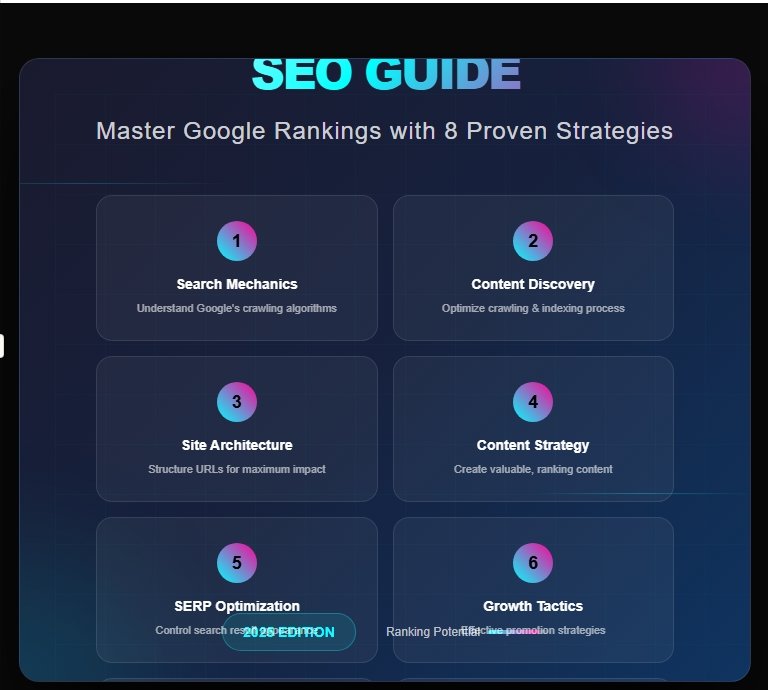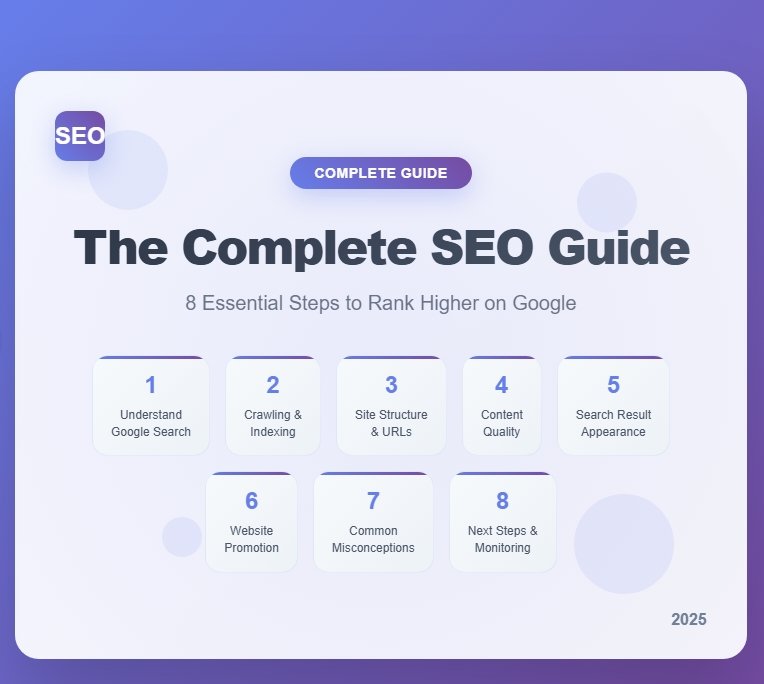Search engine optimization remains one of the most powerful ways to drive organic traffic to your website. With billions of searches happening daily, understanding how to make your content discoverable can transform your online presence. However, SEO has evolved significantly, and many outdated practices can actually hurt your rankings.
This comprehensive guide breaks down the exact steps you need to take to improve your search visibility, based on Google’s latest recommendations and proven strategies that work in today’s competitive landscape.
Table of Contents

Understanding How Google Actually Works
Before diving into tactics, it’s crucial to understand Google’s fundamental process. Google operates as an automated search engine using sophisticated programs called crawlers that continuously explore the internet. These crawlers follow links from page to page, discovering new content and adding it to Google’s massive index.
Think of Google’s index as a library catalog containing billions of web pages. When someone searches, Google’s algorithms scan this index to find the most relevant and valuable results. Your goal as a website owner is to ensure your content gets discovered, properly understood, and deemed worthy of ranking for relevant searches.
The foundation of successful SEO lies in following Google’s “Search Essentials” – fundamental guidelines that help search engines understand and rank your content. Sites that ignore these essentials often struggle with visibility, regardless of how much effort they put into other optimization tactics.
Step 1: Ensure Google Can Find and Index Your Content
The first step in any SEO strategy involves making sure Google knows your website exists. Many website owners assume their content is automatically discoverable, but this isn’t always the case.
Checking Your Current Index Status
Start by performing a simple site search on Google. Type “site:yourwebsite.com” into Google’s search bar, replacing “yourwebsite.com” with your actual domain. This shows you exactly which pages Google has indexed. If your important pages don’t appear, you have a discovery problem that needs immediate attention.
Making Your Content Discoverable
Google primarily finds new pages through links from existing indexed pages. This creates a network effect where well-connected content gets discovered faster. The most effective way to facilitate discovery involves promoting your content through various channels, encouraging natural linking from other websites over time.
For those comfortable with technical implementation, submitting a sitemap provides Google with a roadmap of your most important pages. Many content management systems generate these automatically, but you can also create them manually. A sitemap doesn’t guarantee indexing, but it helps Google understand your site’s structure and priorities.
Ensuring Proper Page Rendering
Google needs to see your pages the same way your visitors do. This means your CSS, JavaScript, and other resources must be accessible to Google’s crawlers. When these elements are blocked, Google might misunderstand your content or fail to recognize its value.
Use Google Search Console’s URL Inspection Tool to see exactly how Google renders your pages. This tool reveals potential issues with resource loading and helps you identify problems before they impact your rankings.
Step 2: Organize Your Site Structure Strategically
A logical site structure benefits both search engines and users by making relationships between pages clear and navigation intuitive.
Creating SEO-Friendly URLs
Your URLs serve as breadcrumbs in search results, helping users understand whether a result matches their needs. Descriptive URLs that include relevant keywords perform better than random strings of numbers and letters. For example, “yoursite.com/seo-guide-beginners” communicates more value than “yoursite.com/post12345.”
Implementing Smart Directory Structure
For larger websites, organizing similar content into directories helps Google understand your site’s themes and update frequencies. This organization influences how often Google crawls different sections of your site, potentially improving the discovery speed of new content in active categories.
Managing Duplicate Content
Duplicate content wastes crawling resources and can confuse search engines about which version to show in results. While not a penalty-worthy offense, duplicate content creates inefficiencies that can impact your overall SEO performance.
Specify canonical URLs for pages with similar content, or implement redirects from duplicate pages to your preferred version. Google often handles this automatically, but taking control ensures your preferred pages get the ranking credit they deserve.
Step 3: Create Content That Genuinely Serves Your Audience
Content quality remains the most impactful factor in SEO success. No amount of technical optimization can compensate for content that fails to meet user needs or provide genuine value.
Writing for Humans First
Create content that reads naturally and provides clear value to your target audience. Well-organized text with proper headings, short paragraphs, and logical flow improves both user experience and search engine understanding. Avoid keyword stuffing or writing that feels forced – modern Google algorithms easily identify and penalize such tactics.
Developing Unique Perspectives
Originality sets your content apart in crowded search results. Rather than rehashing existing information, bring your unique experience, insights, or research to topics within your expertise. This approach naturally creates content that stands out and earns recognition from both users and search engines.
Maintaining Content Freshness
Regularly review and update your existing content to maintain its accuracy and relevance. Fresh, current information often ranks better than outdated content, especially for topics that evolve quickly. Consider setting up a content audit schedule to systematically review and refresh your most important pages.
Understanding Search Intent
Consider the various ways people might search for your content. Users with different knowledge levels use different terminology – someone might search for “charcuterie board ideas” while another searches for “artisanal cheese presentation.” Understanding these variations helps you create content that captures broader search traffic.
Strategic Internal and External Linking
Links serve as pathways for both users and search engines to discover related content. Internal links help distribute page authority throughout your site and guide users to relevant information. External links to high-quality, trustworthy sources can enhance your content’s credibility and provide additional value to readers.
Write descriptive anchor text that clearly indicates what users will find when they click. Avoid generic phrases like “click here” in favor of specific descriptions that help both users and search engines understand the linked content’s relevance.
Step 4: Optimize Your Search Result Appearance
Your content’s appearance in search results directly impacts click-through rates, which can influence rankings over time.
Crafting Compelling Title Tags
Title tags serve as headlines in search results and significantly impact user decisions to click. Effective titles are unique, descriptive, and include your target keywords naturally. Include your brand name and location information when relevant, but prioritize clarity and user value over keyword density.
Writing Effective Meta Descriptions
Meta descriptions provide the snippet text below your title in search results. While not a direct ranking factor, compelling descriptions can improve click-through rates. Keep descriptions concise, unique for each page, and focused on the primary benefit users will gain from your content.
Optimizing Visual Content
Images and videos can serve as discovery points, especially as visual search grows in popularity. Use high-quality images placed near relevant text to provide context. Add descriptive alt text that explains the image’s content and relationship to your page topic.
For video content, create descriptive titles and descriptions while embedding videos on standalone pages with relevant supporting text. This approach helps search engines understand your video content and can improve visibility in both regular and video search results.
Step 5: Promote Your Content Effectively
Creating great content is only half the battle – effective promotion ensures your target audience discovers it.
Diversifying Promotion Channels
Use multiple promotion channels including social media, email marketing, community engagement, and both online and offline advertising. Word-of-mouth promotion remains highly effective but takes time to develop. Invest in other promotion strategies while building your reputation and natural referral traffic.
Avoiding Over-Promotion Pitfalls
Excessive promotion can backfire by fatiguing your audience or appearing manipulative to search engines. Focus on providing value in promotional efforts rather than simply pushing your content. Engage authentically with communities and provide helpful responses that naturally lead people to your content when relevant.
Step 6: Avoid Common SEO Misconceptions
Understanding what NOT to focus on can save significant time and resources while preventing potentially harmful practices.
Outdated Practices to Avoid
Meta keywords tags have no impact on Google rankings and waste time to maintain. Similarly, keyword stuffing creates poor user experiences and violates Google’s spam policies. Focus on natural keyword usage that serves readers rather than attempting to manipulate search algorithms.
Myths About Technical Factors
Content length alone doesn’t determine rankings – there’s no magical word count that guarantees success. Similarly, the choice between subdomains and subdirectories should be based on business needs rather than SEO considerations, as Google treats both similarly for ranking purposes.
The number and order of headings don’t directly impact rankings, though proper semantic structure helps accessibility and user experience. Focus on creating logical content hierarchy that serves readers rather than trying to manipulate search algorithms through heading manipulation.
Step 7: Monitor and Maintain Your SEO Efforts
SEO requires ongoing attention and optimization rather than one-time setup.
Setting Up Proper Monitoring
Google Search Console provides essential insights into your site’s search performance, including which queries drive traffic, how your pages appear in results, and technical issues that might impact rankings. Set up monitoring to track your progress and identify opportunities for improvement.
Planning Long-Term SEO Management
Consider long-term factors like site migrations, international expansion, or multilingual content that might impact your SEO strategy. Planning these changes carefully can prevent ranking losses and capitalize on growth opportunities.
Implementing Structured Data
Valid structured data can make your pages eligible for enhanced search features like review stars, event information, or product details. While not required for basic rankings, these features can improve visibility and click-through rates for eligible content.
Staying Current with SEO Best Practices
SEO continues evolving as Google refines its algorithms and user behavior changes. Stay informed through official Google resources including the Search Central blog, social media channels, help forums, and educational content.
Focus on fundamental principles of creating valuable, user-focused content while maintaining technical best practices. This approach provides the foundation for long-term SEO success regardless of specific algorithm changes.
Remember that effective SEO requires patience and consistency. While some improvements can show results quickly, building sustainable organic traffic typically takes months of consistent effort. Focus on creating genuine value for your audience, and search rankings will follow naturally as your content proves its worth to both users and search engines.
The key to SEO success lies in understanding that search engines want to provide the best possible results to their users. By aligning your efforts with this goal – creating content that genuinely serves your audience while following technical best practices – you’ll build a strong foundation for long-term organic growth.


